
Climate Change and Security Deep in the Heart of Texas – San Antonio
Podcast: Play in new window | Download
Subscribe: Apple Podcasts | RSS
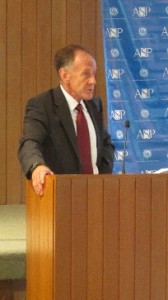 On Tuesday, June 10, representatives of the American Security Project visited San Antonio, Texas for a series of meetings, public events, and briefings on how climate change is affecting security, and how institutions in the region are planning for it.
On Tuesday, June 10, representatives of the American Security Project visited San Antonio, Texas for a series of meetings, public events, and briefings on how climate change is affecting security, and how institutions in the region are planning for it.
Attending were BGen Stephen Cheney, USMC (ret.), ASP’s CEO and Lt. General Norman Seip, USAF (Retired). Cheney is the CEO of the American Security Project, and a 30 year veteran of the Marine Corps. Seip currently serves as an advisor to the Air Force. His most recent operational assignment was as the Commander of 12th Air Force (Air Forces Southern), Davis-Monthan Air Force Base, Ariz. As the Deputy Combined Forces Air Component Commander for U.S. Central Command, General Seip had a direct impact in supporting combat operations in operations Iraqi Freedom. Both are members of ASP’s Consensus for American Security. Andrew Holland, ASP’s Senior Fellow for Energy and Climate, and Porter Brockway, ASP’s events manager, rounded out the delegation.
 Army Installation Management Command, Fort Sam Houston
Army Installation Management Command, Fort Sam Houston
The first stop on the tour was to the headquarters of the Army Installation Management Command (IMCOM) at Fort Sam Houston. Army IMCOM is the result of a recent (2002) consolidation of base support operations under one command – removing redundancies from across other operational commands. Today, IMCOM manages over 14,000,000 acres in 70 installations in the United States and around the world. It has almost 40,000 miles of utility infrastructure, over 2,200 miles of railroads, and almost 800 million square feet of building space.
As the manager of such a large amount of infrastructure in diverse regions around the world, IMCOM is at the front-line of the Army’s preparations for climate change. They must prepare for climate change because they are seeing the impacts already. Coastal bases (admittedly more a feature for the Navy than the Army) are at risk from a combination of sea level rise and storm surges. In arid regions, already dry conditions are combining with more prevalent and deeper droughts to harm water availability at bases. Drought can also harm the ability to train, as drier conditions in live-fire training ranges can actually lead to wildfires. For example, in the summer of 2013, artillery training at Fort Wainwright in Alaska caused a wildfire that threatened homes near Fairbanks. Ironically, also in arid regions, the Army must prepare for more extreme rain events – because climate change is expected to increase such rain events – which could harm infrastructure. For example, in the summer of 2013 at Fort Irwin in California, monsoon rains washed out bridges, damaged barracks, and harmed areas of the National Training Center.
In 2014, as a part of a DoD-wide initiative, the Army has been undergoing a series of vulnerability assessments for its coastal installations. In the future, they have plans to expand these comprehensive vulnerability assessments to all other Army sites.
One area vulnerability that the Army has identified is base energy security. They have ramped-up efforts to build “Net-Zero” facilities across the coutnry. The goal for these facilities is to use only as much energy as they can produce on base (using renewable energy), to use only as much water, and to produce zero net waste. The Net Zero initiative will be important for providing a framework going forward.
As the ASP delegation left, we committed that we would travel to other Army sites around the country to highlight the important work that the Army is doing to address the challenges of climate change.
San Antonio Public Event: Climate Change, Risks for National Security
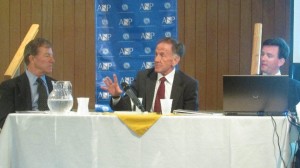 That evening, ASP presented to local audience put together by the Texas Drought Project at University Presbyterian Church. ASP presented to an audience composed mostly of church members about how climate change interacts with America’s security. It started with an outline of the science of climate change, then Generals Cheney and Seip noted how climate change is already affecting global security. Finally, General Cheney discussed how Texas is clearly threatened by climate change, noting how, in an April speech, Federal Reserve Bank of Dallas President Richard Fisher called water scarcity Texas’ biggest potential threat.
That evening, ASP presented to local audience put together by the Texas Drought Project at University Presbyterian Church. ASP presented to an audience composed mostly of church members about how climate change interacts with America’s security. It started with an outline of the science of climate change, then Generals Cheney and Seip noted how climate change is already affecting global security. Finally, General Cheney discussed how Texas is clearly threatened by climate change, noting how, in an April speech, Federal Reserve Bank of Dallas President Richard Fisher called water scarcity Texas’ biggest potential threat.
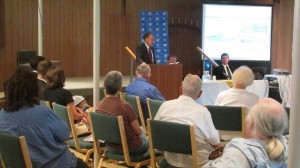 Even without climate change, water is a challenge for Texas: the population of 25 million is projected to grow to 34 million by 2030. Climate change will exacerbate this problem, as higher temperatures increase evaporation, cause an increase in water demand from agriculture, and an increase in electricity consumption. This is happening now: the USDA indicated that, in Texas, 52 percent of the pastures and rangeland were rated in poor to very poor condition due to drought
Even without climate change, water is a challenge for Texas: the population of 25 million is projected to grow to 34 million by 2030. Climate change will exacerbate this problem, as higher temperatures increase evaporation, cause an increase in water demand from agriculture, and an increase in electricity consumption. This is happening now: the USDA indicated that, in Texas, 52 percent of the pastures and rangeland were rated in poor to very poor condition due to drought
There were a number of questions focused on how climate change would impact America’s military force posture and our ability to intervene around the world. Many other questions focused on how climate change is expected to impact Texas, and what local cities and individuals can do about it.
To listen to the whole event, click the podcast above.
San Antonio Dos Rios Sewage Facility
The final event in San Antonio was a tour of the San Antonio Water System’s Dos Rios sewage treatment facility.
Since it came online in 2010, Do Rios is the only water management facility in the world that reuses or recycles everything that comes through. There are three streams of waste that flows out of a sewer treatment plant: solid, liquid, and gas. This is the only facility in the country that reuses all of the three waste streams.
In a typical sewage treatment facility, the raw sewage coming in goes through a settling process to separate the “solids” (an industry euphemism for, well, you know) from the water. Then, when that sludge is removed, microbes are introduced to the water that is able to remove the “solids” that are still suspended in the water.
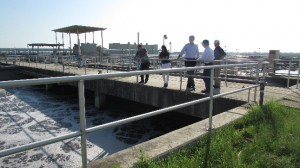 All the solids are then combined into a “sludge” (another good industry euphemism) that is then pumped into enormous digesters where microbes are added that can digest the sludge. Like the emissions from a landfill, these sewage emissions are often then flared away, and the leftover sludge is put in a landfill.
All the solids are then combined into a “sludge” (another good industry euphemism) that is then pumped into enormous digesters where microbes are added that can digest the sludge. Like the emissions from a landfill, these sewage emissions are often then flared away, and the leftover sludge is put in a landfill.
The managers of the San Antonio Water System decided that there was a better way: these are wasted resources. The solids are brought outside to dry in the hot Texas sun, where they are then sold to the New Earth Company where they are combined with green waste and turned into compost that will increase the fertility of the ground.
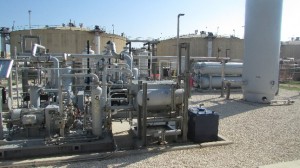 The gas is captured and run through a purifying process that (at least to my untrained eye) was very similar the landfill gas. They produce about 1.5 million cubic feet per day of this renewable biogas, which is then pushed into the interstate pipeline system and onward to Santa Barbara in California, where it is burned for electricity. The California utility gets credit for using renewable power, and San Antonio gets a nice revenue stream of about $20,000 per month.
The gas is captured and run through a purifying process that (at least to my untrained eye) was very similar the landfill gas. They produce about 1.5 million cubic feet per day of this renewable biogas, which is then pushed into the interstate pipeline system and onward to Santa Barbara in California, where it is burned for electricity. The California utility gets credit for using renewable power, and San Antonio gets a nice revenue stream of about $20,000 per month.
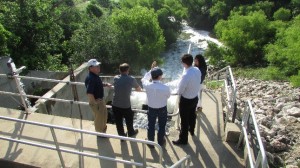 Meanwhile, the water has now been purified by these processes to the point where it can be reused as grey-water – or, as the San Antonio Water System calls it, the “purple pipe.” This water is not drinking water quality, but it is of high enough quality to be put back into the San Antonio River, and to be used for a variety of other purposes. The famous riverwalk in San Antonio is filled with water from the purple pipe. The purple pipe waters the golf courses of the region, and a large coal power plant uses this reclaimed wastewater for cooling and to drive the turbine.
Meanwhile, the water has now been purified by these processes to the point where it can be reused as grey-water – or, as the San Antonio Water System calls it, the “purple pipe.” This water is not drinking water quality, but it is of high enough quality to be put back into the San Antonio River, and to be used for a variety of other purposes. The famous riverwalk in San Antonio is filled with water from the purple pipe. The purple pipe waters the golf courses of the region, and a large coal power plant uses this reclaimed wastewater for cooling and to drive the turbine.
In fact, an additional benefit for purple pipe customers is that reclaimed wastewater is not subject to usage restrictions during a drought – so, even in the deep drought that Texas has suffered under for years, the San Antonio River remains a tourist attraction, and the golf courses can remain green.
Conclusion: Remember the Alamo
 In San Antonio, our hotel was only two blocks from the Alamo. As I walked around it, I was struck by how small the place is. For this place to be revered as the “Shrine to Texas Liberty” that it is today is to show just how much has changed. It shows how the actions of a determined few can literally change the course of history. Just 189 Texans were able to hold an army 1,800 just long enough. They all gave their lives, but those extra days gave General Sam Houston’s forces long enough to gather in strength enough to later defeat the Mexican Army at the Battle of San Jacinto.
In San Antonio, our hotel was only two blocks from the Alamo. As I walked around it, I was struck by how small the place is. For this place to be revered as the “Shrine to Texas Liberty” that it is today is to show just how much has changed. It shows how the actions of a determined few can literally change the course of history. Just 189 Texans were able to hold an army 1,800 just long enough. They all gave their lives, but those extra days gave General Sam Houston’s forces long enough to gather in strength enough to later defeat the Mexican Army at the Battle of San Jacinto.
The lesson for today is not that we should simply lay down our lives for a cause, but that a determined few can literally change the course of history. If a few true believers are willing to work hard enough and sacrifice enough, maybe they will bend the curve of history against what seems like unlikely odds. The cause of climate action started many years ago with a determined few scientists trying to tell the world about the danger. Today, governments and the people are finally listening.

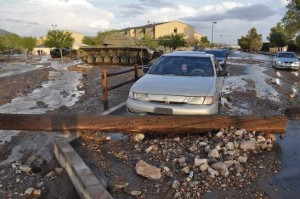





[…] Climate Change and Security Deep in the Heart of Texas – San Antonio Andrew Holland […]
[…] Climate Change and Security Deep in the Heart of Texas – San Antonio Andrew Holland […]